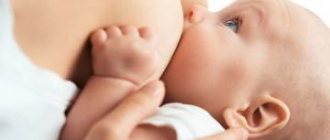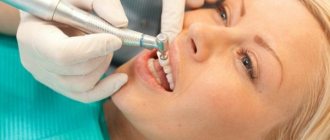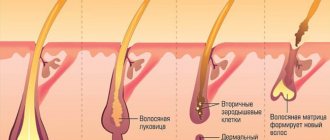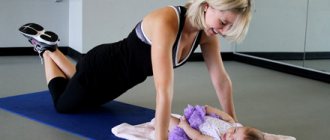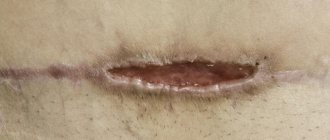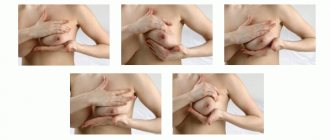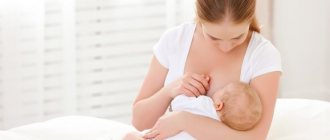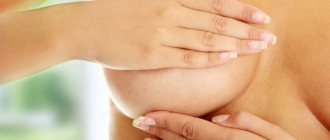In a nursing mother, the main cause of this rather serious disease is lactostasis - this is stagnation of milk, characteristic of situations when the rate of filling the breast is high, and the intensity of sucking in the child is insufficient. The chest becomes like stone, and the woman experiences very strong pain. Lactostasis or postpartum mastitis can begin both on the very first day of a woman’s milk supply, and on any other day throughout breastfeeding. It is very important not to miss the moment and prevent the occurrence of mastitis during breastfeeding, which develops very quickly.
How to distinguish mastitis from lactostasis: symptoms of mastitis in a nursing mother
Mastitis is divided into several stages. Each of them has its own characteristics:
1. Serous mastitis in women (initial) stage has the following symptoms:
- the appearance of cracks in the nipples;
- significant deterioration in general condition (weakness, increased body temperature, lack of appetite, insomnia);
- increase in breast volume;
- soreness, especially when putting the baby to the breast and expressing milk.
If the symptoms of serous mastitis in nursing are ignored and there is no treatment, then over the next couple of days mastitis will enter the infiltrative stage.
2. The infiltrative stage got its name because of infiltrates - compactions with a diameter of up to 3 or more centimeters that formed in the affected mammary gland.
In addition, there are other symptoms of mastitis in nursing mothers:
- redness of the skin of the breast;
- increase in body temperature up to 39°;
- signs of intoxication of the body (weakness, dizziness);
- soreness and enlargement of the axillary lymph nodes;
- In the blood test, an increase in leukocytes and ESR.
When this clinical picture appears, it is necessary to urgently seek medical help, otherwise the pathology passes into a purulent stage, which requires surgical intervention.
3. The purulent stage is the last and has pronounced signs of mastitis in a nursing mother:
- significant redness of the skin and an increase in the size of the affected gland;
- unbearable pain when touched;
- presence of pus in milk;
- sudden change in body temperature;
- feverish chills;
- increased sweating;
- nausea and vomiting.
If timely treatment is not started, mastitis develops into phlegmous and then gangrenous.
4. In the phlegmous form, inflammation very quickly affects the entire gland. Characteristic features:
- increase in body temperature up to 40°;
- chills;
- rapid pulse;
- enlarged and painful lymph nodes;
- nipple retraction (very common);
- constant dry mouth;
- a sharp increase in the size of the mammary gland;
- breast swelling;
- redness of the skin of the affected gland (with areas of blue discoloration);
- expansion of the saphenous veins.
5. Having passed into the gangrenous stage , mastitis leads to necrosis of the skin.
- the inflammatory process spreads to all organs located in the chest area, which leads to severe intoxication;
- the mental state is very unstable (complete apathy or severe agitation);
- pulse up to 130 beats per minute;
- the functioning of all vital organs is disrupted;
- rapidly progressing anemia.
At this stage of mastitis, the probability of death is very high.
In fairly rare cases, purulent mastitis can become chronic. This is usually associated with long-term treatment with penicillin. With chronic mastitis, symptoms in nursing mothers are as follows:
- body temperature does not rise above 37.8° (or within normal limits);
- general health is satisfactory;
- An almost painless lump is felt in the mammary gland.
Depending on the symptoms of mastitis, treatment is prescribed. In a nursing mother, if the problem is detected early, the disease can go away within a week with the help of folk remedies. In more severe forms, antibiotics cannot be avoided; they should only be prescribed by a doctor.
Treatment of mastitis in a nursing mother
How to treat mastitis in a nursing mother? If a woman seeks medical help with a developed disease, she is prescribed antibacterial therapy. It is worth understanding that antibiotics are prescribed to a nursing mother for mastitis when traditional medicine cannot help, so you should not ignore the doctor’s recommendations. In this case, the doctor must take into account whether the woman intends to continue breastfeeding in order to prescribe the most gentle antibiotic.
During the period of treatment, it is recommended that the nursing mother transfer the baby to artificial feeding in order to avoid harm to the child, which is inevitable when taking antibiotics.
Also, for mastitis, drugs that suppress lactation are prescribed to prevent stagnation of milk in the breast. In the case when the effect from them is insufficient or there is no effect at all, the woman needs to pump regularly at intervals of three hours.
Treatment with folk remedies
In order to speed up the healing process, the doctor advises, in addition to taking antibiotics, not to neglect traditional medicine, the effect of which has been proven for centuries.
Naturally, in no case should you ignore the treatment prescribed by your doctor and fight mastitis only with folk remedies, since they are not able to overcome infectious mastitis on their own.
Folk recipes against mastitis that pass from one generation to another, for example:
- a compress of cabbage leaves, which is applied to the chest and secured with a bandage at night. This procedure is carried out over several days;
- salt compress, in which a cotton napkin or towel soaked in warm salt water is applied to the chest and left until it cools completely;
- an alcohol compress, which is applied to the affected areas and left until completely dry;
- an ointment made from plantain seeds, which is quite simple to prepare: pour crushed plantain seeds with warm water. When applied regularly to inflamed areas, the effect will not take long to appear;
- lotions from infusion of linden flowers;
- ichthyol ointment.
It is believed that for mastitis it is useful to eat apples and lemons daily, which reduce inflammation of the mammary glands.
Breast hygiene
After childbirth, women's breasts swell greatly from the flow of milk. They need support. It is important to choose a quality bra. It should be comfortable, elastic, made of natural fabric, without underwires, with wide straps. Such a bra will help avoid stretch marks, protect the breasts from injury, ensure optimal blood circulation and milk flow, and remove excess stress from the spine. It is advisable to have several bras (at least two) to change them daily. If milk leaks from your breasts, you can put special pads in your bra cups or make them yourself from 8 to 10 layers of sterile bandage.
Daily breast massage and taking a contrast shower will help improve blood circulation in the mammary glands and avoid stretch marks. Massage your breasts with water jets in a clockwise motion with warm and cool water alternately. After taking a shower, wipe your breasts with a towel using movements from the nipple to the armpit. Wear special supportive tops at night.
To keep your mammary glands in shape, do special exercises to strengthen your breasts. Here are some exercises. Repeat each at least 20 times.
- Clasp your hands in front of your chest, palms facing each other, as if in supplication. Squeeze your palms tightly for a few seconds, then release.
- Stand up straight, place your hands on your waist. As you rise onto your toes, move your elbows back as far as possible.
- Take an expander or a tight, wide elastic band about 50 cm long. Raise your arms above your head, stretch the elastic band, and hold it taut for ten seconds.
- Push-ups (from the floor or a chair) also help strengthen the muscles that support the chest.
Take a look at our section “After childbirth (for mom)” where you will find
Breast massage for mastitis in a nursing mother
One of the effective aids in the treatment of mastitis is breast massage. It is very important that a nursing woman can do it on her own without visiting a medical facility.
Already at the initial stage of mastitis, the inflamed mammary glands must be massaged with light stroking movements around the mammary gland, then rubbed from the edge to the center, as if kneading the lump. The procedure takes approximately 10 minutes.
Causes of elevated dihydrotestosterone in women and men, and how to treat it?
The use of Epigen-intim gel and spray: whether there are any analogues for the product can be found here.
Postinor as a remedy against unwanted pregnancy: .
Is it possible to breastfeed with mastitis?
The question of breastfeeding during mastitis is asked by every woman who has a breastfed child. But no matter how much she would like not to replace her milk with an alternative diet, the doctors firmly stand their ground: with this disease of any form, you should not feed a child - neither with a healthy breast, nor with a sick one. Since pathogenic microorganisms are already present in mother’s milk, which will certainly lead to disruption of the gastrointestinal tract. Antibiotics that are prescribed to treat mastitis also have a detrimental effect on the child’s health. In order not to transfer the baby to artificial formula, milk must be expressed and boiled, and only then given to the child.
How to tell if your baby has enough milk
It is difficult to find out how much milk a baby consumes at a time when feeding. And control weighing is powerless here. When a baby is breastfed on demand, he sucks a different amount of product each time. This can be 120 ml, sometimes 10 ml is enough. You can figure out whether your baby is full by the following signs:
- baby's skin is fresh and elastic;
- he is gaining weight and growing well;
- when feeding, the sound of swallowing is heard;
- dark and frequent stools.
If the baby is healthy, cheerful and happy, obviously everything is fine, he eats well and has enough milk.
There is a technique that helps to more accurately determine whether the baby is getting enough nutrition while breastfeeding. It is based on the amount of urine that a baby produces per day; it is used all over the world. To do this you need to count wet diapers:
- Usually, a baby normally pees about 8 times a day, and there should be the same number of wet diapers per day. When the urine is clear and light, without odor, it means that he is receiving enough milk.
- For those who find it difficult to part with diapers for the whole day, it is possible to reduce the test time to 3 hours. Usually, the baby urinates during wakefulness after about half an hour, sometimes more often. If during this period he pees 4 times, everything is fine,
When the number of urinations is 3 times, you will have to extend the test time by another 3 hours. The normal result is at least 4 urinations.
You can weigh the diapers that your child has wet during the day. To prevent moisture from leaving them, it is better to put them in a plastic bag or weigh them after each shift, then add up the result. Approximate urine norms are presented in the table.
| Age (months) | Urine volume (ml) or part of weight |
| 2 | 400 |
| 3 | 1/3 |
| 4 | 1/3 |
| up to 6 | 500 |
If the baby does not pee enough, it means there is not enough milk.
How to prevent mastitis from occurring?
Of course, no woman is immune from such an unpleasant disease as mastitis, but there are several simple recommendations to reduce the risk:
- Proper latching of the baby to the breast.
- very important to maintain hygiene , but do not go to the extreme of washing your breasts after every feeding. This disrupts the protective microflora of the nipples, causing cracks to appear into which bacteria can enter, which will trigger the onset of the inflammatory process.
- Also, to avoid cracks, it is recommended to allow the breasts to air out, that is, you should not wrap them in clothes immediately after feeding.
- It is necessary to minimize visiting places where large numbers of people gather , since there is too high a chance of catching some kind of infection that can cause complications. After all, the body of a woman who has recently given birth has not yet recovered, and her immunity is significantly reduced.
- For the same reason, a young mother should avoid drafts and choose clothes made from natural, breathable fabrics.
- Put the baby to the breast as often as possible to avoid lactostasis.
In conclusion, it should be repeated that mastitis is a serious disease that requires urgent medical attention. Only he can prescribe effective treatment. Under no circumstances should you rely only on folk remedies and advice from older relatives.
It is very important for a woman to monitor her health and not ignore even the slightest signs of lactostasis. Excessive worries for a young mother will also not bring any benefit, so do not panic and completely switch the child to formula, since with timely treatment, mastitis can be successfully treated. When all health problems are behind you, you can safely continue breastfeeding.
Treatment of mastitis at the first signs:
How to get back into shape?
The experience of the famous woman Cindy Crawford, who put on her old tight-fitting clothes a few days after giving birth, is something many women are not lucky enough to experience.
Therefore, in order to quickly and timely bring all parts of your body back to normal, in particular the chest and tummy, immediately (you just need to recover from childbirth for at least a couple of weeks) after the birth of a child, you should adhere to the following recommendations of specialists (everything is individual, but there are general principles):
- Body weight control . Breast size, shape and firmness directly depend on body weight. As mentioned earlier, heavy mammary glands sag under their own weight, losing tone and size. Both weight gain and weight loss should not be sudden and rapid.
- Prevention of stretch marks . Once pregnancy occurs, a woman's body undergoes changes. Weight gain after 9 months should not exceed 12 kg, all this time the breasts must be moisturized with cosmetics. Fortunately, any pharmacy department has a variety of special creams to combat stretch marks. The main rule is to start the fight before the stretch marks begin to appear.
- Nutrition . A properly formulated diet allows you not only to control body weight, monitor your figure and health, but also help restore breast elasticity and improve hormonal levels. There are a number of foods rich in phytohormones that mimic female sex hormones. Protein foods will strengthen the muscles of the body, tighten muscles and fill the mammary glands with nutrients. Foods that contain monounsaturated fats will fill the breasts with additional fats, increasing their size.
- Water treatments . You can prevent the appearance of stretch marks and sagging skin in the chest area by using a contrast shower. Cool water and a change in its temperature will restore tone to the breasts, improve blood flow and saturate the breasts with oxygen.
- Massage . After water procedures, the maximum effect of it for breast lift can be achieved if you regularly self-massage the mammary glands. Moisturized skin should be pinched, stroked, and gently kneaded. This will increase blood circulation, give the breasts firmness and help them regain their former youth.
- Physical exercise. In order to restore a slim body and firm breasts after childbirth, special physical exercises that strengthen the muscles of the back, shoulders, and chest will be useful. This could include arm swings, push-ups, and arm exercises with dumbbells.
- Cosmetical tools . In the assortment of pharmacies there are various safe creams that give the breast skin elasticity. Such drugs do not have a negative effect on the glandular tissues of the breast, which produce breast milk in the future. It is important to choose a proven and reliable manufacturer.

